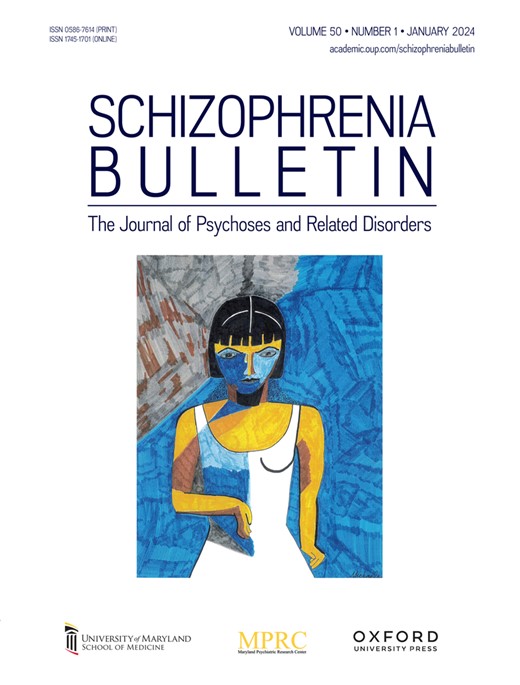Association between the Korea-Polyenvironmental Risk Score and Clinical Outcomes in Schizophrenia Spectrum Disorders
IF 5.3
1区 医学
Q1 PSYCHIATRY
引用次数: 0
Abstract
Background Evidence suggests that environmental factors increase the risk of psychosis development and influence the prognosis of psychotic disorders. This study examined the discriminative validity of the Korea-Polyenvironmental Risk Score (K-PERS) in differentiating patients with schizophrenia spectrum disorders (SSDs) from healthy controls (HCs). In addition, we evaluated its associations with baseline clinical characteristics and short-term clinical outcomes. Study Design Data were obtained from participants of the Korea Early Psychosis Study, who were assessed using K-PERS and underwent clinical evaluations at baseline and at 2, 6, and 12 months. Matched HCs were recruited for comparison. Psychopathology, cognitive functioning, and socio-occupational functioning were assessed using the Positive and Negative Syndrome Scale (PANSS), Prospective and Retrospective Memory Questionnaire (PRMQ), and Social and Occupational Functioning Assessment Scale (SOFAS). Treatment response, remission, and recovery were evaluated based on predefined criteria. Results A total of 224 subjects with SSD and 203 HC were enrolled in this study. K-PERS-I and K-PERS-II demonstrated good predictive performance, with area under the curve values of 0.738 and 0.754, respectively. At baseline, K-PERS-I and K-PERS-II were significantly associated with depressive and negative symptoms, PRMQ scores, SOFAS scores, and various self-reported measures. Importantly, several individual item scores or total score of K-PERS predicted treatment response, remission, or recovery. Conclusions K-PERS has a good discriminative ability for identifying SSDs within the general population. Furthermore, K-PERS is associated with symptom severity, cognitive performance, and socio-occupational functioning, and it significantly influences the illness course.韩国-多环境风险评分与精神分裂症谱系障碍临床结果的关系
背景证据表明,环境因素会增加精神病发生的风险,并影响精神病的预后。本研究检验了韩国-多环境风险评分(K-PERS)在区分精神分裂症谱系障碍(ssd)患者和健康对照(hc)中的判别效度。此外,我们还评估了其与基线临床特征和短期临床结果的关系。研究设计数据来自韩国早期精神病研究的参与者,他们使用K-PERS进行评估,并在基线、2个月、6个月和12个月时进行临床评估。招募匹配的hc进行比较。采用Positive and Negative Syndrome Scale (PANSS)、Prospective and Retrospective Memory Questionnaire (PRMQ)和Social and Occupational functioning Assessment Scale (SOFAS)对精神病理、认知功能和社会职业功能进行评估。根据预先定义的标准评估治疗反应、缓解和恢复。结果共纳入224例SSD和203例HC患者。k - pes - i和k - pes - ii具有较好的预测效果,曲线下面积分别为0.738和0.754。在基线时,k - pes - 1和k - pes - ii与抑郁和阴性症状、PRMQ评分、SOFAS评分和各种自我报告的测量结果显著相关。重要的是,K-PERS的几个单项得分或总分预测了治疗反应、缓解或恢复。结论K-PERS对普通人群的ssd有较好的鉴别能力。此外,K-PERS与症状严重程度、认知表现和社会职业功能相关,并显著影响病程。
本文章由计算机程序翻译,如有差异,请以英文原文为准。
求助全文
约1分钟内获得全文
求助全文
来源期刊

Schizophrenia Bulletin
医学-精神病学
CiteScore
11.40
自引率
6.10%
发文量
163
审稿时长
4-8 weeks
期刊介绍:
Schizophrenia Bulletin seeks to review recent developments and empirically based hypotheses regarding the etiology and treatment of schizophrenia. We view the field as broad and deep, and will publish new knowledge ranging from the molecular basis to social and cultural factors. We will give new emphasis to translational reports which simultaneously highlight basic neurobiological mechanisms and clinical manifestations. Some of the Bulletin content is invited as special features or manuscripts organized as a theme by special guest editors. Most pages of the Bulletin are devoted to unsolicited manuscripts of high quality that report original data or where we can provide a special venue for a major study or workshop report. Supplement issues are sometimes provided for manuscripts reporting from a recent conference.
 求助内容:
求助内容: 应助结果提醒方式:
应助结果提醒方式:


